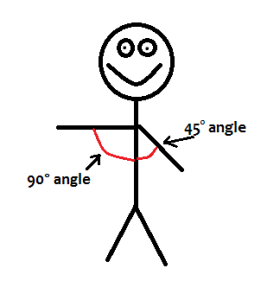You know what? There’s nothing I like more than a good set of push-ups.
Okay, maybe a fair few other things.
But saying it like that really drives home the level of how much I dig them, right?
Okay okay, before you get all “damn, he lied to us”, let me breakdown what makes these so damn good though. And with that, why they’re a key exercise I like to include in most, if not, all of my clients’ programs.
Why.
Along with a chin up, a push-up is a great sign of strength for any individual. Hands down. Not only are they hard to perform, but they’re also hard to do with great technique.
What makes a good push-up in one person’s eyes, can be an absolute train wreck to another.
Which is why we can see things like this happening everyday:
And hell, even this:
*Eye balls bleed*.
If we also throw in the commonality of people smashing them out with the classic head poke, hips drooping, and even the ol’ elbow-winging action, you can see that there is seriously a wide range of push-up variations.
Today though, I want to try and teach you some epic ways of getting the most out of them, and even show you some cool ways of gaining the strength required for them.
And in some cases, without even performing an entire rep.
True story.
Let’s get this party started.

I think the best thing I can do first is go through what and why these bad boys are such a highly praised exercise.
If we think about it; an exercise that can strengthen and/or hypertrophy practically all of our muscles, one that is great for creating and maintaining our upper body mobility and stability patterns, one that can basically be performed anywhere (except in zero gravity areas), and one that has so many regressions and progressions (making them a viable option for almost everyone), it really is hard to not be on the pro-push-up side of the fence.
Hang on a minute. Surely you didn’t mean ALL of the muscles in your body, did you, Hayden? Isn’t it just for the chest, bro?
Well, let’s have a quick breakdown of the muscles involved in a good solid push-up.
Musclez.
Starting from our hands and feet that clench and make contact with the ground, to our legs and arms that help stabilize us, and right the way to our torso and glutes that help hold tension throughout the movement – everything really plays a part.
I will admit however, that there might not be direct contraction and relaxation of all of your muscles, but if done right, they are at some extent, all playing a part in the entire contraction of your body as a whole.
Joint by joint.
If you remember the joint-by-joint approach we touched on last week, you’ll recall that the scapula sure does love being stable with a nice and unrestricted freedom to move over the rib-cage.
But what is quite common to see are people putting a huge emphasis on scapula retraction and protraction and making this exercise into more of a reverse row.
Which might not be a huge negative other than the fact that it destroys the emphasis on the ideal targeted muscles and joints that you should be focused on during the movement (the glenohumeral joint – for those playing at home).
Anyway, by learning to work off a solid base by providing a stable foundation for your push-ups, you will be able to generate a helluva lot more force in the movement. And at the same time, even save your joints/muscles in the long-run.
Pretty good, right?
However, before we move on, yes, the scapulae don’t have to remain completely locked down for a push-up in comparison to, let’s say, a bench press, but the tendency for too much freedom within the scapula region can create a negative pattern in other areas of your body.
Errors.
For instance, by not finding stability in the proper areas, like the scapula for the push-up, the body then has to find the stability somewhere else.
And the next closest points of course, are the shoulder and neck.
This is one reason why the shoulder-hike-to-neck and neck-poking-forward style of push-ups is so common.
The body is literally trying to find stability in the wrong areas.
You see, your body doesn’t really give a damn how it compensates and performs things, as long as it keeps you alive.
However, being able to retrain less-than-ideal patterns isn’t too hard of a feat to accomplish.
And it all starts with awareness.
Correcting errors.
Elbows winging, shoulders hiking, neck poking forward and hips dropping are the four most common errors seen during the push-up.
And the best ways to remedy these occurrences are simple steps like switching on your scapular stability and holding the tail tuck. Two topics we’ve covered before.
But for the neck poking individuals out there, packing your neck, or quite simply, making a double chin is the best option.
And to understand this, what I want you to do right now is try it out.
Firstly, sit up tall so that your chest is high (boobs out). Next, push on your chin towards the back of your head using your hand. What you should feel is tension through the back of your neck and of course, be sporting one of those nice double chins that nobody likes to see.
Easy, right?
Now in regards to the elbow winging, following creating tension for a solid scapula stability base with your lats and other muscles, look for a 45° angle in between your upper arm and side of your body.

This can be best achieved by changing up the position of your hands.
And using around a one-hand outside shoulder width position seems to be the best bet for the most activation, control and stimulation throughout the movement.
Not to mention that this elbow angle prevents your shoulder rolling forward through the movement and can save the health of your shoulders too.
So after dealing with all of the above, we can now get into the good stuff and I can give you some awesome little regressions that you can have a shot at if you’re having trouble owning this movement.
Regressions.
This first one is great for simply building strength through the body and preparing you to actually perform them.
You can make things harder by adding things in like shoulder taps.
This teaches you to switch on in the right places at the right time and hold tension throughout the set.
These above two I can guarantee if you master within a month or so, you’ll be able to dominate in push-ups. Even if it’s just for 3-5 reps.
And as you can see, without ever even performing a push-up.

This next one however, is a great one to add in that gives you the ability to learn what level of control is required for the lowering portion of the movement.
You can also try out alternatives like having your hands elevated on a box, bench, bar, etc.
And of course, mix it up with some good ol’ fashioned knee push-ups.
Progressions.
This really is one of the big reasons as to why this exercise is so damn good. There are literally countless amounts of progression possibilities.
I won’t bore you with the classic feet elevated alternative, that shits obvious. But cool ones to increase the difficulty and demand can be simply loading yourself up with more weight.
Jumping on a suspension trainer apparatus like the TRX.
And even increasing the demand upon the upper body by adding movements to the push-up like the downward dog.
Or a twist with your body.
Fin.
There really is nothing lamer than awkward 3° elbow bends, hips drooping all over the place, necks shooting forward and shoulders hiking up into your ears that are considered to be push-ups.
So always remember to stay locked on and tight throughout the movement. Use your depth as a gauge and always aim for your chest to touch/be aiming for the ground first.
I guarantee that all of the above really will help you out with your push-up domination.
Questions? Drop em below.


